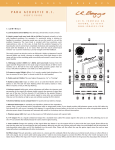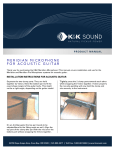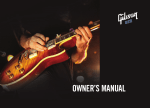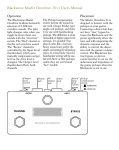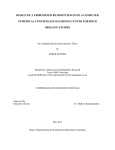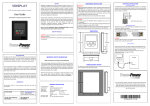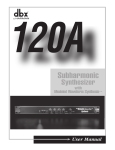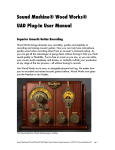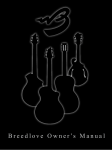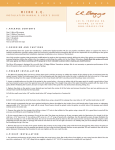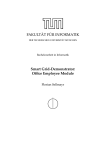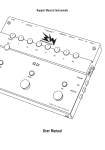Download MAMA BEARTM - Seymour Duncan
Transcript
MAMA BEAR TM User Manual for MAMA BEAR Digital Acoustic Guitar Preamp For years, acoustic guitars have relied on pickups for amplification. One problem: Even the best acoustic guitars deliver an oversimplification of true acoustic tone complexity when amplified. Using something called AGE™ tecnology, D-TAR’s Mama Bear takes your guitar into the digital realm and restores the natural body resonance. The result: now the finest acoustic guitars can sound like, well… themselves. Only louder. “with respect to acoustic tone” TM mama bear FCC INFORMATION (U.S.A.) Table of Contents 1. IMPORTANT NOTICE: DO NOT MODIFY THIS UNIT! This product, when installed as indicated in the instructions contained in this manual, meets FCC requirements. Modifications not expressly approved by D-TAR may void your authority, granted by the FCC, to use this product. QUICK START pg. 1 INTRODUCTION pg. 3 2. IMPORTANT: When connecting this product to accessories and/or another product, use only high quality shielded cables. Follow all installation instructions. Failure to follow instructions could void your FCC authorization to use this product in the USA. AGE TM pg. 5 PANEL DRAWINGS pg. 6 CONTROLS EXPLAINED pg. 8 TECHNICAL SPECIFICATIONS pg. 17 LIMITED WARRANTY pg. 17 INPUT SOURCES AND TARGET INSTRUMENTS pg. 18 3. NOTE: This equipment has been tested and found to comply with the limits for a Class B digital device, pursuant to part 15 of the FCC Rules. These limits are designed to provide reasonable protection against harmful interference in a residential installation. This equipment generates, uses and can radiate radio frequency energy and, if not installed and used in accordance with the instructions, may cause harmful interference to radio communications. However, there is no guarantee that interference will not occur in a particular installation. If this equipment does cause harmful interference to radio or television reception, which can be determined by turning the equipment off and on, the user is encouraged to try to correct the interference by one or more of the following measures: —Reorient or relocate the receiving antenna. —Increase the separation between the equipment and receiver. —Connect the equipment into an outlet on a circuit different from that to which the receiver is connected. —Consult the dealer or an experienced radio/ TV technician for help. If these corrective measures do not produce satisfactory results, please contact the local retailer authorized to distribute this product. If you cannot locate the appropriate retailer, please contact D-TAR Customer Service at: 5427 Hollister Ave. Santa Barbara, CA 93111-2345 USA. The above statements apply ONLY to those products distributed by D-TAR or its subsidiaries. Fill in the following for your reference: Date of Purchase: Purchased From: Serial Number: TM mama bear Quick Start: Get Up And Running Fast 4. Set all the controls like this (pay careful attention to the switch settings): You’re anxious to start using Mama Bear, but you don’t want to read a manual yet. Fair enough. However, read these next two pages so that you get on the right track immediately. Play around and then read the rest of the manual. It covers important details about Mama Bear, and tells you how to get the most out of it and to get the best sound ever from your acoustic guitar. 5. Turn on Mama Bear by pressing the Power switch. 1. Plug the AC adapter’s cord into the back of Mama Bear, and plug the AC adapter into a live outlet. 6. Turn on your amp, preamp, or mixing console. 2. Plug Mama Bear into a mixing console, preamp, or acoustic guitar amp in one of these ways: A. Use a cable with XLR (3-pin) plugs to connect to a mixing console. B. Use a shielded cord with 1/4” plugs to connect to an amp or preamp. 7. Strum your guitar and slowly bring up Mama Bear’s Input Level control until you see the Overload LED barely light up when you hit the strings hard. Note: If your guitar has a volume control, make sure it’s turned up at least 50% or higher. Also check its battery (if it uses one) and replace it if it’s dead or weak. For best results, connect your Mama Bear to a high-quality sound system (P.A. system, highquality powered speakers, etc.). 8. With your amp, preamp, or mixing console volumes set to normal levels, bring up Mama Bear’s Output level. Be careful not to make it too loud, and adjust your other equipment’s input levels if necessary to maintain good levels without distortion. Note: If you connect Mama Bear to high-quality powered speakers, you will need cables with the appropriate connectors. 9. Check the Phase switch setting. If you are encountering feedback or if your guitar sounds extra-hollow, try pushing the Phase switch. This inverts the signal’s phase and can thwart feedback or bring more “body” into your tone. (If your amp is on the floor, try raising it up. The “bass coupling” effect that comes from a speaker close to the floor causes extra bass heaviness and can cause feedback.) 3. Plug your acoustic guitar’s cord into Mama Bear’s input jack. 1 TM mama bear 10. Here’s the fun part. Try different settings on the Input Source and Target Instrument selectors and listen to how your guitar sounds. Adjust the Blend knob to change the mix between your straight guitar sound and Mama Bear’s enhanced sound. 11. Experiment with the Blend control. Turning the knob to the Dry end of the dial gives just the sound of your guitar without any of Mama Bear’s processing. The Wet end of the dial is the processed sound only. Every setting between these two extremes is a blend of your original guitar tone and the enhanced tone from Mama Bear. Important! Feedback is possible at some settings, so always monitor your volume levels. You’re now ready to experiment with Mama Bear’s expressive qualities. After you play for a while and become familiar with the controls and how they affect your tone, read the rest of this manual. It provides in-depth information about getting the most out of Mama Bear and the best sound ever from your guitar. 2 TM mama bear Introduction for anyone running a sound system in which acoustic instruments are being amplified. You can quickly bypass the AGE sonic shaping to hear what your guitar sounds like unprocessed, plus you can blend the straight sound of your guitar with the processed signal, allowing an incredible range of new acoustic tones. With Mama Bear, it’s possible to make a fine-quality acoustic guitar sounds its best; plus, it smooths out and improves the tone of lower-quality guitars or those with lower-quality pickup systems. Mama Bear works equally well with steel-string and nylon-string acoustic guitars, providing a wide range of tone-shaping options. The sonic qualities of hybrid instruments that employ magnetic and under-saddle transducers can also be improved, smoothed, or altered. TM For years, acoustic guitars have relied on pickups for amplification, but even the best acoustic guitar tone is reduced to an oversimplification of its true complexity when amplified. Mama Bear takes your acoustic guitar’s tone into the digital realm through its 32-bit digital signal processor. Then it restores the natural body resonance and provides you with a broad range of sonic enhancements that make your guitar sound its absolute best when amplified or recorded. Because of its input source matching capabilities and its tonal shaping that emulates the complexities of 16 classic acoustic guitars, Mama Bear will take your guitar into previously uncharted sonic territories. Despite giving you unprecedented control in sonic shaping of your acoustic tone, Mama Bear is simple to use. With just two controls—Input Source and Target Instrument—you can: Mama Bear is a unique digital signal processor preamp/effects unit featuring AGE (Acoustic Guitar Emulation) technology that improves the character of amplified acoustic guitars by adding the spatial dimension that no pickup system or analog effects can produce alone. It is designed to work with all acoustic guitars outfitted with magnetic pickups, under-saddle acoustic transducers and electric guitars with piezo bridge saddles. It is not designed to work with microphones, soundboard transducers or accelerometers. Mama Bear provides you with the means to give your acoustic guitar the sonic qualities of a broad range of great-sounding acoustic guitars, both vintage and modern. TM 1. Alter or smooth out the response of your guitar’s pickup. Surprisingly, even the best acoustic guitars with the best pickups often need fine-tuning due to the sonic inconsistencies of amplifiers or speakers, or the way pickups and speakers interact with your instrument. Rather than spend hours experimenting with graphic and parametric equalizers (or replacing a low-quality pickup), you can put Mama Bear’s advanced signal processing to work balancing the tonal range from low to high. You’ll find that placing Mama Bear between even the best pickup/guitar combination and amplifier will improve the tone. More Important Stuff Mama Bear can be used as a stand-alone preamp or placed in the channel insert loop of a mixing console. In addition, Mama Bear has a balanced direct output to interface with recording consoles or PA systems. Therefore, it’s not only perfect for the solo guitarist or player in a group, but it’s also a great tool 2. Overlay 16 “sonic signatures,” the sound that comes from the interaction of wood and air in a guitar, onto the sound produced by your strings, fingers, and guitar. These “sonic signatures” are based on some of the greatest guitars ever built. 3 TM mama bear TM We call this aspect of the AGE technology 3-D EQ . TM An added bonus is that you don’t need to alter your instrument, and can use virtually any magnetic pickup or under-saddle transducer (“UST”). Plus, Mama Bear lets you mix your guitar’s straight sound with the enhanced tone to give you an infinite range of “custom blends.” What won’t Mama Bear do? While Mama Bear can make a mediocre guitar sound pretty darned good, nothing can make a bad-sounding guitar or a bad-sounding amplifier sound great. A bad-sounding guitar or poorly designed pickup starts you out with a deficient tone, and no amount of electronic wizardry can completely compensate for such a problem. And, amplifiers designed for electric guitars are voiced to sound best with an electric guitar, with exaggerated bass response and a natural tendency to distort. While this sounds good for electric guitar, it’s the opposite of what you want for an acoustic: namely clean, evenly balanced tone over a wide range. As mentioned above, it’s not compatible with soundboard transducers or microphones. Its capabilities are maximized with USTs, magnetic soundhole pickups or solid body electric guitars with piezo bridge saddles. 4 TM mama bear The Secret of Mama Bear’s Success: Acoustic Guitar Emulation (AGE ) A variety of magnetic pickups, transducers (UST or otherwise attached to the top), and small microphones are employed in many guitars, often with uneven results. Possible mismatches between the pickups and amplifiers, speakers that aren’t suited to the task of amplifying an acoustic guitar, and bad room acoustics can erode the sound of even the best pickups. Using EQ can often tame some of the problems like feedback and boominess, and remedy some weaknesses; but still, there can still be a gulf between what your guitar sounds like unamplified, and what it sounds like through an amp or PA system. With Mama Bear’s sophisticated Acoustic Guitar Emulation (AGE) technology, it’s possible to bring your amplified sound more in sync with the tone that naturally comes from your guitar, even if you don’t have an elaborate or expensive pickup system. TM Our research has shown that the true sound of an acoustic instrument consists not only of variations in frequency response, but also of changes in that response over time. As different areas of a guitar’s top are excited into motion when you play, some of these areas move in and out of phase, certain frequencies are delayed as they’re turned into acoustical energy, and the air resonance of the body takes some time to store and release its energy contribution to the overall tone of the instrument. It is the sum and difference of all these complex vibrations that become the tone we seek. The signature sound doesn’t happen on any particular spot of the instrument, but rather coalesces at a distance from it, where all the complexity comes together in a form we recognize as its characteristic sound. The 3-D EQ in Mama Bear not only corrects frequency imbalances and the sometimes ever-present harshness of some pickups, but it also adds in the critical time and phase adjustments that make up the sonic “fingerprint” of your instrument. This results in restoring its tone and integrity, making it sound truer. Mama Bear also provides the flexibility to blend in the characteristics of some of the greatest acoustic guitars of all time, bringing out new dimensions in your guitar’s sonic personality. Unfortunately, this phenomenon of sonic buildup, shaping, and blooming in the air means that the best place to hear—and to amplify—the sound of an acoustic guitar is several feet away from the top. It’s the sound you love when playing with others in a circle in your living room or at a festival, but it’s also the sound you can never quite get onstage, no matter how complex a pickup system you use or how much conventional EQ you employ while trying to achieve that combination of clarity and warmth you know your guitar has. Of course, placing a microphone several feet away from your guitar isn’t practical in onstage settings or anywhere amplification is involved. Feedback, stray room resonances, and other noises conspire to make a guitar sound inferior, or at least “off.” 5 TM mama bear Front & Rear Panels 1 2 6 3 4 5 7 8 9 14 10 11 Front Panel 12 13 8. Mute LED indicator 9. Mute pushbutton switch 10. Phase pushbutton switch 11. Output Level control 12. Input Source selector 13. Target Instrument selector 14. Power LED indicator 15. Power on/off pushbutton switch 1. Input jack (1/4” mono) 2. Analog Lo-Cut filter 3. Input Level control 4. Overload LED indicator 5. Blend control (wet/dry) 6. Bypass LED indicator 7. Bypass pushbutton switch 6 15 TM mama bear 1 4 2 Rear Panel 1. 16 volts AC input from AC adapter 2. Ground Lift pushbutton switch 3. XLR Balanced Output jack 4. 1/4” Unbalanced Output jack 7 3 TM mama bear Inputs, Outputs, And Controls Front Panel 1. Input jack (1/4” mono) Plug your guitar into this jack. Use a high-quality shielded guitar cord (never use a speaker cable). When you are not using Mama Bear, it’s a good idea to unplug your cord to reduce risk of damaging Mama Bear. 2. Analog Lo-Cut filter When overlaying the Target Instrument (13) tones onto your guitar’s natural sound, an excessive build up of low frequencies can occur. Depressing the Analog Lo-Cut filter button tames the low frequencies and removes any “woofy” tonal features by engaging a gentle rolloff of frequencies below 200Hz. This can be helpful in compensating for a bottomheavy speaker system or poor room acoustics. You may find it more necessary when using Target Instruments with larger bodies or deeper bass response. If you don’t encounter any excessive low frequency content when you use Mama Bear, then leave the Analog Lo-Cut filter unengaged. 3. Input Level control This knob sets the Mama Bear’s sensitivity to the signal coming from your guitar’s pickup. Use this knob to set the input level so that Mama Bear has a nice, clean, strong signal, but not one that distorts. Use the Overload LED indicator (4) to help guide you. Typically, it will be desirable to have your guitar’s volume up at least 50% or higher. Play as hard as you normally would. In fact, 8 TM mama bear play a little harder, and set the volume so that Mama Bear’s Overload LED barely blinks (see the next section for setting the Level control in conjunction with the Overload LED). The right combination of levels from your guitar and Mama Bear’s input level are critical, so use care in getting a sound that’s clear and strong. If either level is set too low, you can end up with a weak and perhaps noisy signal (depending on the type of preamp in the guitar). 4. Overload LED indicator When the Overload LED indicator starts to blink, it’s telling you that Mama Bear’s digital section has about 6dB of headroom before overload. Overloading at this point in Mama Bear or any other digital device sounds bad and defeats the point of trying to make your acoustic guitar sound its best, so keep an eye (and an ear) on the Input Level control and the Overload LED. The best signal-to-noise ratio is achieved by running the guitar’s volume and the input level as high as possible without clipping (the type of distortion you hear when there’s too much signal for the circuitry to handle). This allows you to run Mama Bear’s output lower, thereby minimizing noise. If you’re in doubt about the correct starting point for your guitar’s volume (if it has one) and Mama Bear’s Input Level setting, turn both knobs to their halfway point and start turning each one up slowly until the Overload LED blinks when you hit your strings hard. 5. Blend control (Wet/Dry) The Blend control adjusts the mixture of the straight sound coming from your guitar’s pickup (Dry) and the AGE-enhanced sound (Wet). This lets you custom-blend a sound that’s uniquely yours. Once you start experimenting with different settings of the Input Source (12) selector and Target Instrument (13) selector, 9 TM mama bear you will discover an extremely wide range of tones and textures. 6. Bypass LED indicator The Bypass LED tells you when the Bypass pushbutton (7) is engaged. 7. Bypass pushbutton switch When the Bypass pushbutton is pushed in, the signal from your guitar’s pickup passes through to Mama Bear’s output without any sonic shaping from Mama Bear’s AGE, although Mama Bear’s input buffers keep the signal strong. Using this switch is great for comparing your “straight” sound with the sound that comes from Mama Bear. 8. Mute LED indicator The Mute LED tells you when the Mute pushbutton (9) is engaged. 9. Mute pushbutton switch Push the Mute button, and the output signal is turned off. This is useful when you’re tuning or changing guitars, so you don’t annoy the audience or damage speakers. 10 TM mama bear 10. Phase pushbutton switch This switch reverses the phase of the signal delivered to the speakers, relative to the vibration signal produced by the top of your guitar. Reversing the phase can help to fight feedback and provide a dramatically different tone. Use this with care, though, because it can sometimes make your tone very strange or make the guitar sound less present. In addition, if you are not experiencing feedback, reversing the phase can possibly introduce feedback. Finally, if you are splitting the signal from your pickup to both Mama Bear and an amp or mixing console where Mama Bear’s output will also go, it’s possible that one of the signals may end up out of phase with the other, causing either a weak tone or one that’s especially “honky” and feedback-prone. If you’re splitting the signal in this way, try pushing in and pushing out the Phase switch to see which setting sounds best. Note: When you move from one location to another on stage (relative to your speakers), it may be necessary to change your phase switch’s setting (in or out) for best feedback cancellation. 11. Output Level control Use the Output Level to set the amount of signal going to an amp, mixing console, etc. If the equipment that Mama Bear is plugged into has an overload indicator at its input, check that and use your ears to get the best level match between Mama Bear and that equipment. Start with both levels turned down, and gradually bring them up. Listen for distortion, and remember that if either Mama Bear’s Output Level or the other equipment’s input level control are set at opposite extremes or if 11 TM mama bear you hear a weak or noisy signal, you should probably “rebalance” the levels. The goal is to get the most signal and the least noise. This is almost always achieved by using the highest input level before clipping and the lowest output level possible—while making sure the sound is loud enough, of course. Note: The XLR Balanced Output from Mama Bear comes before the Output Level Master Volume Control, and as such, Mama’s output is not affected by that knob. This is so you can send the optimum signal to a PA or recording console and control the Mama Bear volume at the console. The Output Level knob only controls the 1/4” Unbalanced Output. 12. Input Source selector This 16-position switch lets you neutralize the effect of your guitar’s pickup on its tone, or it can impart a totally new sonic complexion to the instrument. The Input Source selector covers the range from the thinnest, brightest-sounding under-saddle transducer to fattest magnetic pickup. Starting at 1 and moving to number 15, the texture starts thin and gets progressively thicker. Think of this control as a way to prepare your guitar before it is processed. Select an Input Source setting that matches the type of pickup in your guitar. Keep in mind, there may be more than one match; so listen to a few settings to find the one or two that are best-suited to your instrument. Once you get a feel for what the next control, the Target Instrument selector (13), can do, you’ll definitely want to come back and experiment with different Input Source settings. Together, there are 256 possible combinations! The following pickup products are examples of some of the types listed on the Input Source list 12 TM and should serve as a guide to what type of pickup is in your guitar. If you don’t know what type of pickup you have, that’s OK. Just try and find the one that sounds closest to your guitar acoustically. Also, a little experimentation may unveil cool new tones that you never realized your guitar was capable of making. Ceramic Piezo - D-TAR™ Sadducer™, Ovation™ pickup, L.R. Baggs™ LB6™, Barcus Berry™ UST, Fishman/Martin™ Thinline, SC Laboratories™, Shadow™, RMC Acoustic Gold™ original Takamine™ pickup. Coax Film - D-TAR Timber-Line™, Highlander™ IP-1, Headway™ Flat Film - D-TAR™ Wave-Length™, L.R. Baggs Element and Ribbon Transducer™, Fishman™ Matrix™, B-Band™ UST, EMG™ AS-series. Solid Body Metal Bridge - LR Baggs X-Bridge™, Fishman Powerbridge™, Turner™ Model 1 piezo. Magnetic - Seymour Duncan Mag Mic™ and Woody™, LR Baggs M1™, Fishman Rare Earth™, Sunrise™, Dean Markley™ ProMag™ Input Sources 1 2 3 4 5 6 7 8 Ceramic Piezo UST Ceramic Piezo UST Ceramic Piezo UST Ceramic Piezo UST Coax film Coax film Flat Film UST #2 Flat Film UST #2 #1 #1 #2 #2 9 10 11 12 13 14 15 16 Coax film UST in semi-hollow Coax film UST in semi-hollow Solid body, metal piezo bridge Solid body, metal piezo bridge Solid body, metal piezo bridge #2 Magnetic soundhole pickup Magnetic soundhole pickup Neutral, no input compensation B-Band is a trademark of B-Band Ltd. Barcus Barry is a registered trademark of MBT International. Dean Markley and Pro-Mag are trademarks of Dean Markley Strings, Inc. EMG is a registered trademark of EMG, Inc. Fishman, Matrix, Powerbridge, Thinline and Rare Earth are trademarks of Fishman Transducers, Inc. Headway is a registered trademark of Headway Electronics Pickups. Highlander is a trademark of Highlander Musical Audio Products. L.R. Baggs, LB6, Ribbon Transducer, Element and X-Bridge are trademarks of L.R. Baggs Corporation. Martin and Thinline are registered trademarks of C. F. Martin & Co., Inc.. Ovation and Takamine are registered trademarks of Kaman Music Corp. SC Laboratories is a registered trademark of SC Laboratories, Inc. RMC is a registered trademark of RMC Pickup Co. Seymour Duncan, Mag Mic and Woody are trademarks of Seymour Duncan pickups. Shadow is a registered trademark of Shadow Elektroakustik. Sunrise is a trademark of Sunrise Pickup Systems. Turner is a registered trademark of Turner Guitars. Notwithstanding Seymour Duncan and Turner, D-TAR LLC is not affiliated with these companies. These trademarks are employed solely for the illustrative purpose of describing specific acoustic guitar tones and identifying construction. 13 mama bear 13. Target Instrument selector All 16 positions of this selector give your guitar distinctive characteristics of famous, great guitars. Each one is based on careful recording and analysis of the tone that comes from the design, shape, size, age, wood, and moving air that make up the character of great vintage and modern luthier-crafted instruments. Your guitar takes on sonic proportions that go far beyond mere one-dimensional tone control or simple equalization. Its tone is reshaped in multiple frequency ranges and with a new set of dynamics, sustain, and resonant qualities that add complexity and subtlety to its tone. Target Instruments 1 2 3 4 5 6 7 8 Parlor Small Body Fingerstyle Small Body Blues Mahogany Orchestra Model Rosewood Orchestra Model Boutique Fingerstyle Slope-shouldered Dreadnought Grand Auditorium 9 10 11 12 13 14 15 16 Slope-shouldered Jumbo Mahogany Dreadnought Rosewood Dreadnought Super Jumbo Hollow Body Archtop Jazz Gypsy Jazz Biscuit Blues Resonator Tricone Resonator 14. Power LED indicator When this LED glows, Mama Bear is getting power from the AC adapter. If the Power switch is on (pressed in) and you don’t see the LED glowing, then ensure that Mama Bear’s AC adapter is plugged into a working AC outlet. If you’re not sure whether the outlet is “live,” try another one or test it with another piece of equipment that you know works. If the outlet is controlled by a switch, make sure it’s on. 15. Power on/off pushbutton switch When this pushbutton is depressed, power to Mama Bear should be on and the Power LED indicator should glow. 14 TM mama bear Rear Panel 1. Input from AC adapter Mama Bear is powered by an external AC adapter. Always make sure that its output plug is securely plugged into the rear of Mama Bear, and that the adapter is held firmly in an electrical outlet. Never operate Mama Bear or the AC adapter in the rain or in wet locations. To prolong its life, unplug the adapter when Mama Bear is not in use. Alternatively, the AC adapter can be plugged into a switched power strip so that you can conveniently turn it off with your other gear. Refer to the label on the adapter for proper operating voltages. Note: If your AC adapter, its cord, or its plug is ever damaged or if the adapter fails to work, do not use it. Replace it with the same kind only. Failure to use the proper 16VAC/ 560mA adapter can be hazardous and could damage your Mama Bear. Contact your D-TAR dealer or the D-TAR factory to purchase a replacement. 15 TM mama bear 2. Ground Lift pushbutton switch If you use an XLR balanced cable to connect Mama Bear to other gear, it is possible that a ground loop may occur. A ground loop is an unwanted secondary path between electrical devices that can introduce a steady, annoying 60Hz hum. If you hear such a hum, depress this switch, which disconnects the grounding portion of the XLR output (3) and often removes the ground loop and its hum. Important! Feedback is possible at some settings, so always monitor your volume levels. 3. XLR Balanced Output jack This output is designed to provide a strong clear signal to professional recording gear, PA systems, and any equipment that accepts a low-impedance source via an XLR (3-pin) connector. Note: The XLR Balanced Output from Mama Bear comes before the Output Level Master Volume Control, and as such, Mama’s output is not affected by that knob. This is so you can send the optimum signal to a PA or recording console and control the Mama Bear volume at the console. The Output Level knob only controls the 1/4” Unbalanced Output (see #4 below). 4. 1/4” Unbalanced Output jack This output is optimized for sending a strong, clear signal via a shielded guitar cord to amplifiers, effects devices, and many mixers that have 1/4” inputs. 16 TM mama bear Technical Specifications D/A Conversion 24 bit 128x oversampling 24 bit 8 times digital filter Ripple: +/-0.005dB, Attenuation: 75dB S/(N+D): 94dB Differential outputs Dynamic Range: 110dB, A weighted Size Width Depth Height Unit Weight Shipping Weight TM 8.5” / 216mm 6.25” / 159mm 2.72” / 69mm 2.7 lbs. / 1.2 kg 4.5 lbs. / 2.1 kg Analog Characteristics Nominal Input Level -10dBu 4.4M Ohm Input Impedance 15.5dB, bypassed Gain, input to output Maximum signal level before 2.0Vrms input stage clipping Nominal Output Level * 0dBu Single ended -20dBu XLR Balanced Maximum Output Level before clipping ** Single ended 7.2Vrms, bypassed; 3.5Vrms through processor Balanced XLR 1 Vrms, bypassed; 0.5Vrms through processor Noise, 20 Hz to 20 KHz, bypass mode, referenced to input: 109 dBv, input shorted 97.5 dBv, input open Power Supply External wall mount- ed transformer 16 VAC/560mA Current Draw: 200mA @ power jack * Nominal levels measured using pink noise generator set to 250mV rms. Input level control set to produce flickering of overload indicator; output level control set to maximum. **Maximum output levels in bypass mode measured using 1KHz sine wave. Maximum output levels through processor measured using sine waves of various frequencies from 800Hz to 1.2KHz. Limited Warranty D-TAR offers the original purchaser a one-year limited warranty on both labor and materials starting from the day this product is purchased from an Authorized D-TAR Dealer. D-TAR will repair or replace this product, at its option, if it fails due to faulty workmanship or materials during this period. Defective products should be returned to your USA dealer, international distributor, or sent direct to our factory postage prepaid along with dated proof of purchase (e.g., original store receipt) and a RMA number clearly written on the outside of the box. Please call our factory at 805-964-9610 for an RMA number. Digital Characteristics Microprocessor 32 bit, 100MHz, floating point, 600 MFLOPS Sample Rate: 44.1 KHz Latency: 3ms A/D Conversion 24 bit 64x oversampling S/(N+D): 94dB Dynamic Range, S/N: 108dB This warranty does not apply to damage to this product or an instrument caused by misuse, mishandling, accident, abuse, or alteration. Product appearance and normal wear and tear (worn paint, scratches, etc.) are not covered by this warranty. D-TAR reserves the right to be the sole arbiter as to the misuse or abuse of this product. D-TAR assumes no liability for any incidental or consequential damages, which may result from the failure of this product. Any warranties implied in fact or by law are limited to the duration of this express limited warranty. P/N 501055-125 Rev. B 17 mama bear Input Sources 1 2 3 4 5 6 7 8 Ceramic Piezo UST Ceramic Piezo UST Ceramic Piezo UST Ceramic Piezo UST Coax film Coax film Flat Film UST #2 Flat Film UST #2 #1 #1 #2 #2 9 10 11 12 13 14 15 16 Coax film UST in semi-hollow Coax film UST in semi-hollow Solid body, metal piezo bridge Solid body, metal piezo bridge Solid body, metal piezo bridge #2 Magnetic soundhole pickup Magnetic soundhole pickup Neutral, no input compensation Target Instruments 1 2 3 4 5 6 7 8 Parlor Small Body Fingerstyle Small Body Blues Mahogany Orchestra Model Rosewood Orchestra Model Boutique Fingerstyle Slope-shouldered Dreadnought Grand Auditorium 9 10 11 12 13 14 15 16 18 Slope-shouldered Jumbo Mahogany Dreadnought Rosewood Dreadnought Super Jumbo Hollow Body Archtop Jazz Gypsy Jazz Biscuit Blues Resonator Tricone Resonator TM D-TAR and Mama Bear are trademarks of D-TAR, LLC. © 2005 D-TAR, LLC. 5427 hollister ave santa barbara ca 93111.2345 USA tel 805.964.9610 fax 805.964.9749 www.D-TAR.com






















